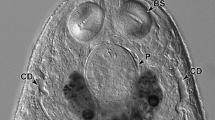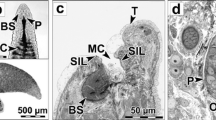Abstract
Newly in vitro excysted tapeworms ofHymenolepis diminuta (Cestoda, Cyclophyllidea), 1- to 3-day-old worms and destrobilated worms from rat intestines were investigated by means of light microscopy (LM) and scanning electron microscopy (SEM). It was found that the scolex of 1- and 2-day-old worms had shallow suckers with smooth brims, while 3-day-old and older worms, including destrobilated worms, had deep suckers with puckered brims. The posterior end of 1- and 2-day-old worms had a central cone-shaped structure not present in 3-day-old and older, or destrobilated worms. The repairing of the posterior end and the protonephridial system after excystation or destrobilation was much the same. Tissue remnants moved into the centre of the posterior end, resulting in an indentation with a pore to the exterior. The indentation and its pore became connected to the emptying canals of the protonephridial system, i.e. they developed into the excretory bladder and pore respectively.
Similar content being viewed by others
References
Hesselberg CA, Andreassen J (1975) Some influences of population density onHymenolepis diminuta in rats. Parasitology 71:517–523
Hindsbo O, Andreassen J, Ruitenberg J (1982) Immunological and histopathological reactions of the rat against the tapewormHymenolepis diminuta and the effects of anti-thymocyte serum. Parasite Immunol 4:59–76
Hopkins CA, Subramanian G, Stallard H (1972) The effect of immunosuppressants on the development ofHymenolepis diminuta in mice. Parasitology 65:111–120
Lumsden RD, Specian R (1980) The morphology, histology and fine structure of the adult stage. In: Arai HP (ed), Biology of the tapewormHymenolepis diminuta. Academic Press, New York, London, Toronto, Sydney, San Francisco, p 157
Lyons KM (1969) Compound sensilla in the monogenean skin parasites. Parasitology 59:625–636
Malmberg G (1972) On the early development of the protonephridial systems in some species belonging to the generaDiphyllobothrium, Triaenophorus andSchistocephalus (Cestoda, Pseudophyllidea). Zoologica Scripta 1:227–228
Rothman AH (1959) Studies on the excystment of tapeworms. Exp Parasitol 8:336–364
Smyth JD, Barrett NJ (1979)Echinococcus multilocularis: Further observations on the strobilar differentiation in vitro. Rev Iber Parasitol 39:39–53
Smyth JD, Davies Z (1974) In vitro culture of the strobilar stage ofEchinococcus granulosus (sheep strain): A review of basic problems and results. Int J Parasitol 4:631–644
Author information
Authors and Affiliations
Rights and permissions
About this article
Cite this article
Malmberg, M., Andreassen, J. & Malmberg, G. Hymenolepis diminuta: A comparison between young developing, and small, destrobilated worms in the rat intestine. Z. Parasitenkd. 71, 747–757 (1985). https://doi.org/10.1007/BF00926800
Accepted:
Issue Date:
DOI: https://doi.org/10.1007/BF00926800




